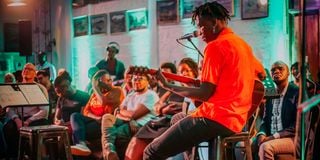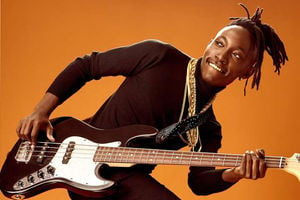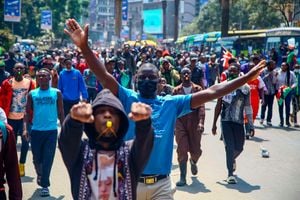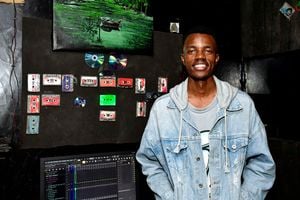
Brian Sigu, an afro-fusion musician based in Nairobi and founder of Afrofused Rhythms.
I find the music industry one of the most rapidly changing fields in the country and the world. Possibly because artistes understand the need to keep their fans entertained but more so hooked on their creation, they do this by supplementing their recorded music with other fun activities. Because of this, trends are created as quickly as they are overtaken.
In Kenya, the popularity of live music performances is leading to the rise of listening parties. Loosely defined as events where an artiste gathers their fans to sample an upcoming album or single, these parties are slowly becoming a must-do for musicians, both famous and upcoming.
While there are no particular structures to an album listening party, most artistes seemingly favour two main approaches. One way is for the artiste to simply play the album over a sound system to the audience. The other approach is to have live performances of the tracks by the artiste. For instance, while at Bien’s listening party, a DJ was playing his songs as people interacted with the artiste and with themselves over drinks, the latter approach is what Blinky Bill went with.
Blinky announced his newest solo Album, ‘We Cut Keys 2’ released officially in January this year, with an exceptional live performance and DJ set during his listening party in a show that wasn’t only sold out but was also attended by many artistes and celebrities. The Album, a successor of 2020’s ‘The Play House’ and coming seven years after the EP ‘We Cut Keys While You Wait’ assembled distinguished musicians from different genres in the 16-track album, such as Fuse ODG in ‘Konstant K’, Maji Maji (of Gidi Gidi Maji Maji) in ‘Boss’ and Shaunna Fung Yee and another in ‘Kiberit’.
From the onset, Blinky’s new album was a favourite of many. In an online post, Blinky Bill narrates meeting a fan months after the listening party and the fan getting excited talking about their experience at the listening party.
Like everything showbiz, listening parties aren’t obligated to be good; plenty of supposedly high-end musical events in this country have made that obvious by now. And yet, ‘We Cut Keys 2’ album listening party was a masterpiece.
Blinky Bill brought out the funkiness that his music is known for by alternating between live DJ sets and his performance. At some point, he brought on stage traditional dancers to perform alongside.
Overall, the album listening party was a high-concept show built around creating fun with already-great tracks, and pop aesthetics- funky dressing and the energy of Blinky’s very particular fan base.
Entertainment purposes
Listening parties are however not just hosted for entertainment purposes only. They can be crucial to the creation process for the artiste. So, at what stage do artistes have their listening parties and are they the final step before the album or song is released or can an artist make changes to the work after?
“The individual pieces or even the entire album or EP may be adjusted- if the artist so wishes- after a listening party,” Brian Sigu tells me, “But often, you will find that changes at this stage are very minimal because most artistes have wrapped up production and are awaiting launching or releases.”
I am at the WEAL House Hall on Ngong Road, and a man in a purple ‘Man of Nyadhi’ branded t-shirt leads me up the stairs into a warm orange and blue lit sitting area- that turns shadows into silhouettes- where Brian Sigu is hosting an album listening party on a chilly July evening.
It’s only slightly over a year after the launch of his third album ‘Apaka’ and he is returning with his fourth, titled ‘A Man of Nyadhi’, which in some ways reaffirms his strengths in the previous three albums: great vocals blended with the longing ache always present in his songs and his trademark, charming banter.

Guitarist and lead vocalist Brain Sigu on stage during Showcase Wednesday at Alliance Francaise on January 22, 2020.
“I try to limit the tickets to my listening parties because I like them to be intimate events. While my album launch concerts are open to everyone, I try to have only my most dedicated fans at my listening parties. It’s all about intimacy with the fans. I want them to feel as if they were part of the album,” he says.
At the event, Brian had opted to do a live performance of the about-to-be-released album, bringing on stage, at different points, the artists featured in the new album or whom he had collaborated with previously like Yaba (the Rhumbacane prince, not to be confused with Yebba, the great American vocalist) and Fadhili Itulya among others.
In the album released three months later, here, Brian Sigu mixes some old ‘revisited’ pieces- as he prefers to call them- like ‘Apuoyo’ and ‘Kola’ that were previously featured on his second album ‘Jambaka’ alongside five new ones.
The songs on the album all have different paces, hence creating different moods that are built gradually around the instruments and Brian’s powerful vocals, all sung in Luo. Notably, also, many of the tracks stretch beyond 5 minutes- the shortest, ‘Sulwe’ is 5:22 minutes long.
Listening to the newly released album, I noticed stark differences between the performance at the listening party and the studio recordings released officially on his social media platforms this October.
First, the artiste decided to smoothen some of his transitional notes- ironic because I have always thought his strength as a vocalist lies in high, rasp transitions. For instance, in his intro ‘Akal’ while he maintains the naughtiness in the opening line (translated: ‘my mother has always cautioned me against flirting with widows), he seemingly opts for a mellow following second line- and this has a rather interesting effect of making the verse sound regretful rather than melancholic (which is the impression I got listening to the song at the album party).
However, ‘Apuoyo’ and ‘Isabella’ seem to be improved by the jazz sounds additions (post the listening party) making them my two overall best tracks of the album- ‘Kola’ comes second. ‘Akal’ and ‘Akinyi’ tie third position then ‘Sulwe’. At the listening party, I had ranked ‘Akal’ second.
Also, unlike the performances at the listening party where featured musicians had played, the released album excludes all collabos, preferring to include only his solos. When I reached out to him to inquire about this decision, he had said, “I’m about to bring even hotter things, you’ll see. Watch this space.”
Connection with the fans
Evidently, listening parties are a great way for the artiste to create a community and foster an intimate connection with the fans. But there are many other purposes of a listening party, and some other reasons why an artiste would host one.
“For me, the main reason I had my listening party was to get feedback from my fans,” says Coster Ojwang’. “As artistes, we are where we are because of our fans. So, we must make sure we are aware of how they feel about the art we put out there. After all, you don’t make art for yourself. So, I use listening parties to gauge what my fans think of my music and that also helps predict what the general public will respond to them. So, in short, it is like my testing ground.”
Coster Ojwang’ also fondly known as ‘The Fisherman’ amongst his fans, hosted friends and fans in mid-September this year at Mageuzi Hub for the listening party of his new album titled ‘Imposter Syndrome No More’.
I first came to Coster Ojwang’ rather late through one of his most popular releases ‘Manyo Pesa’ featuring Watendawili, because I was just coming back to the country after being away for quite a while, and it was the hit then. Slowly, I came to like many of his songs, especially ‘Kionge’ and ‘Kipenda roho’ both, part of his first album, ‘Fweny’ which was released about a year ago.
In the new 17-track album, Coster opens with a powerful intro ‘Jowi’ (which was immediately a favourite of many people at the listening party). The rest of the album features familiar big names like Ambasa Mandela in ‘Dance’, Ayrosh in ‘Haaye’ and Savara in ‘Jathum’. There’s also Mordecai (of Hart the Band), Qwiss and Ywaya Tajiri (also featured in two big hits in Coster’s previous album).
At the listening party, in between performances, Coster had an interactive Q&A session on stage- being interviewed on the album and answering questions from the audience.
“Feedback is important for me as an artiste because then I get to know what worked and what didn’t- so I have that in mind as I think of the next project,” he says.





